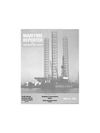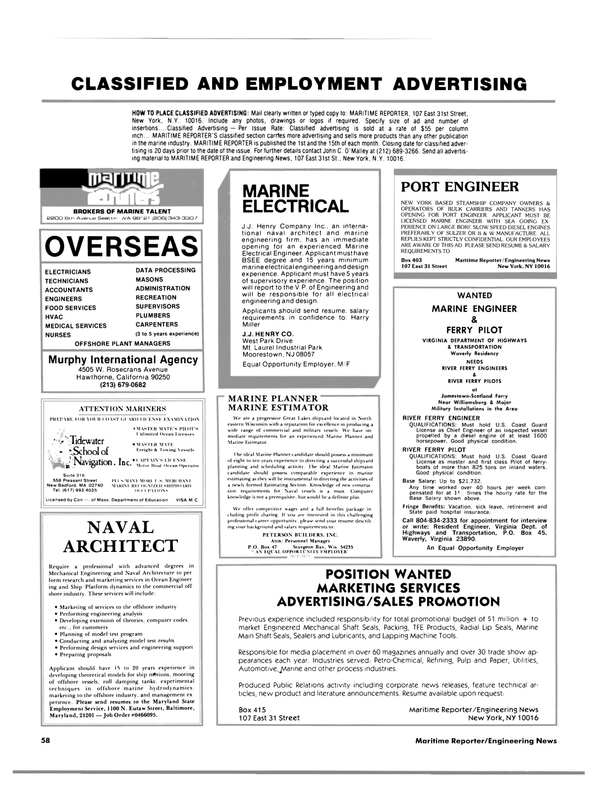
Hyundai Shipyard Delivers Three Barber Blue Sea Line RO/ROs
Built by the Ulsan shipyard of Hyundai Heavy Industries Company, Ltd., the three largest RO/ RO-containerships in the world entered the international service of Barber Blue Sea recently. Called SuperCarriers by their owner, the Barber Tampa, Barber Texas, and Barber Hector are 860 feet long and have a capacity of 2,464 TEUs of containers and 630 Americansized cars. They have been dubbed Free Trade Ships because the success of this $200-million investment depends on free access to the world's markets, according to Raymond R. Miles, executive vice president of Barber Blue Sea. In ceremonies unusual because of their location, the first ship, Barber Tampa, was officially named upon her maiden voyage arrival in the Port of New York.
Headquartered in Oslo, Barber Blue Sea is a consortium of Wilh.
Wilhelmsen of Norway, Ocean Transport & Trading of England, and Brostrom Shipping Company of Sweden. In 1979, BBS introduced its first SuperCarriers, six 1,800-TEU RO/RO-containerships built at a total cost of $200 million.
All of Barber's ships have the capability to transport both containerized and non-containerized cargo, including unboxed cars, rolling stock, trailers, refrigerated cargo, special containers, and heavy lifts.
In order to produce an optimum hull form for the Barber Texas and her two sister ships, a series of model tank tests were conducted at various research centers.
Towing and cavitation tests were repeated as many as nine times at the Norwegian Hydrodynamic Laboratory. In addition, Hyundai retained the Swedish Maritime Research Center to conduct seakeeping and maneuvering tests.
Considerable emphasis has been placed on the ship's safe operation.
To improve damage stability, two watertight transverse bulkheads are partly fitted in the cargo space.
Equal emphasis was put on maximum cargo loading capacity. Three fixed decks and two hoistable car decks are installed and the engine room's size is minimized, providing some 295,470 square feet of cargo deck area. Fixed ramps are fitted between decks.
For fast and easy cargo handling, an angled stern ramp 148 feet long with a minimum clear width of 41 feet is installed. Entrance height at the stern door is 50 feet. A side door with portable car ramp is also provided. At the forward end of the ship, a 40-ton electro-hydraulic cargo crane insures self-sustaining loading and unloading in that area.
Main propulsion is by a Hyundai/ B&W 8L90GB diesel engine with maximum continuous rating of 36,600 bhp at 97 rpm, directly connected to a Kobe Steel propeller.
Service speed of 19.5 knots at design draft of 32 feet is achieved at 85 percent of mcr (32,940 bhp at 94 rpm). KaMeWa 2,300-hp thrusters are fitted forward and aft to improve the vessel's maneuvering performance.
Electric power is provided by three diesel generators of 1,900 kw each, two diesel generators of 900 kw each, and a single turbogenerator of 1,000 kw. The unmanned machinery space can be controlled remotely by Terasaki equipment.
Built to Lloyd's Register of Shipping classification +100 Al, RO/ RO Containership, +LMC, UMS, the Barber Tampa has a molded beam of 105.84 feet, molded depth of 68.90 feet, and scantling draft of 38.38 feet. At that draft the ship has a deadweight of approximately 44,000 metric tons.
Read Hyundai Shipyard Delivers Three Barber Blue Sea Line RO/ROs in Pdf, Flash or Html5 edition of May 1984 Maritime Reporter
Other stories from May 1984 issue
Content
- Lucian Q. Moffitt, Inc. Acquired By BFGoodrich page: 4
- Ritter Joins NMS Shipyard Division As Sales Rep page: 5
- Free Color Brochure Introduces New Stal Refrigeration Plant page: 5
- Eastern Marine Awarded Contract To Construct Auto/Passenger Ferry page: 6
- Valmet Forms Subsidiary In Houston To Serve U.S. Offshore Industry page: 6
- SNAME Philadelphia Section Annual Dinner-Dance Scheduled For June 16 page: 6
- Marinette Marine's $7.1-Million Ship Erection Building Nears Completion page: 7
- Stewart & Stevenson Inc. Appointed Distributors For M W M Series 500 Engines page: 7
- Kone To Build Multipurpose Double-Boom Crane For Port Of Jacksonville page: 7
- Nickum & Spaulding Announces New Executive Appointments — Philip Spaulding Named Chairman page: 7
- New $27.9-Million NKS Plant In Mexico Will Supply Heavy Steel Forgings And Castings To Shipyards And Industry page: 8
- Color Brochure Offered Free From HITCO page: 8
- Newport News Lays Keel For USS Newport News (SSN 750) page: 8
- Marco Seattle Signs Contract To Build All-Steel Workboat page: 10
- Double Naming Ceremony Held At Far East Levingston Shipbuilding page: 10
- Volvo Penta Duoprop Now Available For Workboat Applications page: 11
- Delta Announces Three Appointments page: 12
- Rockwood Introduces New Ball Valve Line — Literature Available page: 12
- World's Biggest Syncrolift Now In Service At Todd's San Pedro Yard page: 12
- Diversified Capabilities Offered By Port Allen Marine Service page: 12
- Harry S. Ford Promoted To Vice President At Autronica page: 14
- Blackmer Pump Offers New Full-Line Catalog page: 14
- SNAME San Diego Section Hears Paper On Sheathing Hulls With Copper-Nickel page: 14
- Marine Safe Electronics Offers Free Literature On 'Fail-Safe' Line page: 14
- Mar A d Awards Cooperative Research Contract To Seaworthy page: 15
- Prock Appointed Vice President/General Manager For Foss Alaska Line page: 15
- Moss Point Marine Launches First Of Two Utility Boats For Argosy page: 15
- POSIDO MIA 5 14 page: 16
- 1984 RTCM ASSEMBLY page: 16
- OTC Begins Study Of HP's Response To Wave Forces page: 19
- Hagglunds Cranes Ordered For Rapid Deployment Force MSC Vessels page: 20
- Isotta Fraschini S.p.A. Awarded Navy Contract page: 22
- Management Changes Announced By Hyundai page: 22
- Navigation & Communications Equipment page: 22
- Le Blanc Joins Moss Point Marine As Director Of Sales And Marketing page: 24
- Edo Awarded $11.4-Million Increase To Navy Contract For Sonar Modifications page: 24
- Ship Structure Committee Publishes Six Technical Reports page: 24
- Mueller Steam Specialty Introduces Basket Strainer — Literature Available page: 25
- Marine coatings & corrosion control page: 26
- PIMA Hosts New York Luncheon On Behalf Of British Shipbuilders page: 43
- Peter Goetz Appointed General Manager Of Electro Dynamic page: 43
- First Marathon Super 300 Jackup Now Drilling In Gulf Of Mexico page: 44
- Anixter Bros. Publishes New Buyers Guide Of Products For Business Communications page: 44
- U.S.-Based Repair Service Introduced by Cityvarvet AB page: 45
- Sternwheeler Landing Queen Delivered By Walker Marine Yard page: 46
- J.L. Konopasek Announces New Organization page: 46
- New Filter Media Offers Greater Protection Against Abrasive Wear page: 49
- New Non-Asbestos High- Temperature Valve Packing Developed By John Crane — Literature Available page: 49
- Krupp Atlas Elektronic Introduces Four New Advanced Radars page: 49
- Mueller Steam Specialty Introduces Duplex Strainers — Literature Available page: 49
- First Of Five RO/RO-Containerships Delivered To ACL By Kockums Yard page: 50
- Bulk Carrier Century Hope Delivered By Mitsui To Hong Kong Owner page: 50
- Saab Control Systems Ordered For Wilhelmsen Product Carriers page: 50
- New Emergency Marker Lights Introduced By ACR Electronics page: 52
- Seminar In New York Introduces New Heavy-Fuel M.A.N.-B&W Engine page: 53
- Hyundai Shipyard Delivers Three Barber Blue Sea Line RO/ROs page: 54
- High-Speed Catamaran Crewboat Delivered By Fjellstrand page: 55
- Omnipure Sanitation Devices Certified By Denmark — Literature Available page: 60
- Foster Wheeler Names Somerville Director-Equipment Business Development page: 61
- Four Executive Promotions Announced By Rosenblatt page: 61
- PBM Introduces New Line Of Valve Manifolds — Literature Available page: 67
- U.S. Navy Solicits Suggestions For Improving Pump Specification page: 67
- New Rope Catalog Available From Samson page: 67


